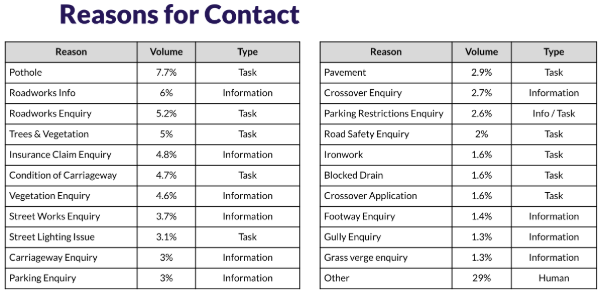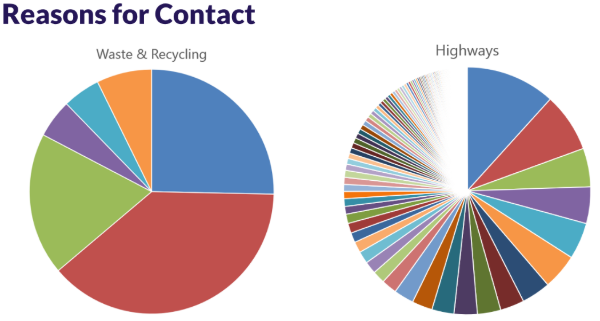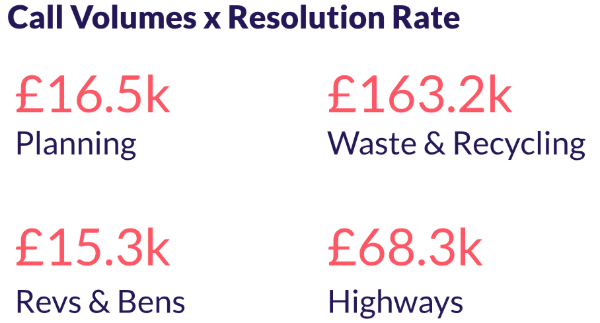Sprint #4: Highways
This week we completed Sprint #4 of the project, looking at Highways services in Surrey (as our only highways authority. As well as user research interviews with 8 members of the public there were stakeholder interviews with 3 staff in the council.
Show and Tell
The complete event is recorded here
Slides from the show and tell are here
Download the show and tell slides
User research interviews
Luiza from Torchbox fed back on the interviews that she and Kyle had conducted.
The key motivation for people engaging with the council was either around something affecting their immediate safety or their community or to reduce both existing and potential negative impacts on their daily life.
Users were predominantly frustrated about not feeling heard; a lot of people said that they would engage with the council to voice their concerns. A lack of response to these concerns was an additional frustration.
There was further frustration around not having the reason for an action (or inaction) explained to users;
“It’s not unreasonable” - this word came up over and over again when speaking to users. “We’re only asking for the minimum, this is common sense - I’m not asking for something impossible”
The subjectivity of the importance of an issue, and how this might differ between council and user was another key factor emerging;
We found something that might not be a priority for the council might be the biggest thing in the user’s life if it’s their driveway that they’re talking about.
This extended to the size of a pothole - the lack of transparency about how its relative importance for repair is assessed led to disagreements between the council and the user.
People were confused as to what classifies a dangerous pothole and they were really struggling to find this information
For Highways there is a good deal of confusion from users around not only how councils are organized but also who’s responsible for what aspect. Everyone had a different answer as to who they thought was the person responsible for either parking or potholes. This confusion leads to a lot of phone calls with users passed from person to contact centre in different organisations until they get through to the right person.
People also had an expectation that council departments, or related organisations, would be more ‘joined up’ than they are in terms of cross-cutting issues like planning a housing development and its impact on traffic or highways. Again, this prompts people to get in touch to vent their frustration.
The motivation for reporting highways issues was not solely about complaining;
All the users that we spoke to have the sense that it’s their civic duty to report issues and to work with the council….they want to be engaged and and want to know that they’re helping to make things better
Experience maps
The two user journeys created for the process were
- complex urban planning enquiries
- reporting an issue or requesting an improvement
For complex planning enquiries the journey often starts with members of the residents association hearing of plans that affect their community that will get together as a community and try to meet with a council representative to voice their concerns and to see how they can help to shape the plans.
Most people felt like they weren’t being listened to. If they did voice their concerns the fact that they didn’t get any follow-up communications to confirm what was heard, what would happen next or what impacts may be meant they didn’t feel involved in the process, and this lead to more communication.
if they feel passionately about something they will keep going until someone gives them some justification…they will continue to try and contact you and take up your time by something that could be sorted with a letter
Reporting an issue or requesting an improvement was more straightforward, but was often guided by a sense of place and the issue’s impact on it;
It’s the things which are causing a real impact in people’s lives and they don’t have any power to do anything about it; they need the council to intervene
Website information for reporting issues was seen as more straightforward than other services areas, but this was often let down by a lack of response to keep people informed.
“It would be nice if the council responded, if they could just tell me what they’re gonna do about it”. One man even said “how lovely would it be if they just closed the loop and showed me a bundle that have been fixed…it would make me feel great, like I have done something for my community”
Even small actions indicating progress, like a pothole being marked with spray paint ready for repair, was reassuring for people.
The time taken to respond or take action was an issue for people as they have expectations that actions can be taken quickly, or they do not fully understand the complexity of an issue like instituting no parking schemes and the length of time this can take. Again, timely responses with indications of timescales would be of benefit and would prevent unnecessary contact.
Stakeholder interviews
Tom Williams from Torchbox had been speaking to key stakeholders in Surrey, as well as using data gathered to date on contact centre activity and website analytics, to get an early view on opportunities to introduce automation in Highways services.
There was some excellent data available on the breakdown of calls

Observations on the data that could be made were;
- The variety of reasons for calling about highways was in stark comparison to the of Waste & Recycling, where 80% of calls could be swept up under 3 main types. For highways, the largest single reason for calling was potholes at just 7.7%

- A narrow-domain chatbot, covering a single task like reporting a pothole, would only have the potential to make a saving of £11,478 in a single council. However, scaling this across all councils across the country then the potential saving becomes far more significant
- Surrey had already migrated a large amount of contact regarding highways defects (73%) to the web. This means a greater degree of calls can already be handled by contact centres
The first line agent who’s handling inquiries across multiple service areas is generally in a position to resolve those as compared to revenues and benefits where the vast majority were being transferred to a back office team
- On call volumes alone a saving of £106k could be estimated. But with 64% being resolved by the contact centre, the potential chatbot gain is lowered to £68.3k

Given the distinct number of reasons for calling and some of the terminology being used there is risk for chatbot confusion
Other findings were that the large number of subcontractors involved in carrying out remedial work, with their systems not always integrating with council systems to give a current picture of progress for contact centre staff to be fully informed. In terms of an AI solution this disparate set of systems makes it challenging to deploy a solution. Surrey are working on ways to tie these back end systems together to improve front line support.
Tom also had a warning about chatbot solutions that ultimately lead to the user being told to make a phone call;
It’s just such a frustrating experience if you bother to engage with this new, shiny, clever bit of tech, then after five minutes of engaging with it it just tells you to do what you would have done already
There is strong opportunity to use conversational AI in terms of providing visual classification for something like quantifying the seriousness of a pothole, and so improve transparency. It is also something that using image recognition would be very easy for a chatbot to do.
As mentioned in the user research, there is a strong need to to focus on updating people with progress, which is becoming a common theme across all service area research.
Next Steps
This week saw the completion of the user research and data gathering phase, with the project now moving into its final stage of distilling and compiling all the information obtained for the final project outputs.
These will all be published on this project site by 23 April 2019.